Research projects
- Cancer Stem Cell Research -Unique challenge to the Cancer Research-
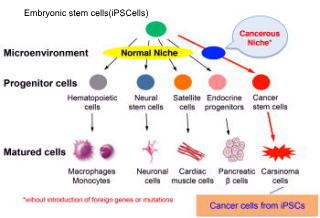 The technology to create artificial pluripotent stem cells was established
in 2006 and it revolutionized the various research efforts to the development
of novel regenerative technologies. iPS cells are capable of differentiating
into different kind of cells including neuronal cells, myocytes and hematopoietic
cells. These cells can be directionally differentiated to the aforementioned
target cells groups and several of the research efforts understanding the
underlying mechanism in this differentiation process are the focus throughout
the world. In our research theme we are utilizing the versatility of the
iPS cells for the production of the cancer stem cells, which eventually is a good source for different types of cancer cells.
The technology to create artificial pluripotent stem cells was established
in 2006 and it revolutionized the various research efforts to the development
of novel regenerative technologies. iPS cells are capable of differentiating
into different kind of cells including neuronal cells, myocytes and hematopoietic
cells. These cells can be directionally differentiated to the aforementioned
target cells groups and several of the research efforts understanding the
underlying mechanism in this differentiation process are the focus throughout
the world. In our research theme we are utilizing the versatility of the
iPS cells for the production of the cancer stem cells, which eventually is a good source for different types of cancer cells.
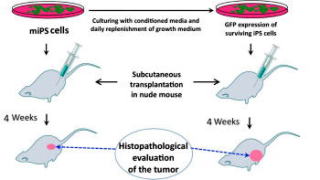 We are inducing the generation of the cancer stem cells with the culture supernatant
from cancer cells, without introducing any foreign genes or genetic mutations,
of the iPS cells. At this stage we have been successful in generating the
cancer stem cells from both human and mouse iPS cells. We are further investigating
the causative factors which direct this induction of cancer stem cells.
We were successful in identifying and developing different types of cancer
stem cells by this method.
We are inducing the generation of the cancer stem cells with the culture supernatant
from cancer cells, without introducing any foreign genes or genetic mutations,
of the iPS cells. At this stage we have been successful in generating the
cancer stem cells from both human and mouse iPS cells. We are further investigating
the causative factors which direct this induction of cancer stem cells.
We were successful in identifying and developing different types of cancer
stem cells by this method.
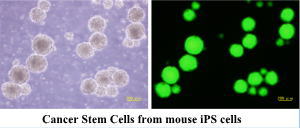
By analogy, considering the versatility of the iPS cells, our methodology has the prospect of generating all types of cancer cells. We are expanding our efforts in preparation of a cancer stem cell collection which will abolish the dependence of patient samples altogether. In Japan cancer has been accounted as the principal death cause for over 30 years, still the effective therapeutic approach to curb the patient mortality rate is required. The presence of cancer stem cells is one of the primary reason for the recurrence of the cancer and with our technology this will be promising in the development of various therapeutic approaches including the possible preparation of unique anticancer compounds. - Development of novel study of profiling tissues and cells.
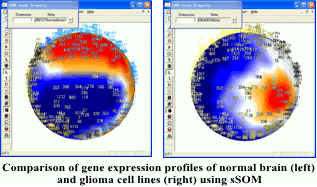 We developed the novel technology of understanding the characteristics of cells and tissues using the Spherical Self Organizing Maps (sSOM). sSOM depicts the representation of the multidimensional analysis data of DNA microarray into simple visual maps. This technology is effective in the large data sets and in data mining, not limiting to DNA microarray alone. Our research focus is expanded to the classification of the newly established cancer stem cells.
We developed the novel technology of understanding the characteristics of cells and tissues using the Spherical Self Organizing Maps (sSOM). sSOM depicts the representation of the multidimensional analysis data of DNA microarray into simple visual maps. This technology is effective in the large data sets and in data mining, not limiting to DNA microarray alone. Our research focus is expanded to the classification of the newly established cancer stem cells.
- Drug delivery system technology by combining liposome and molecular targeting
technology.
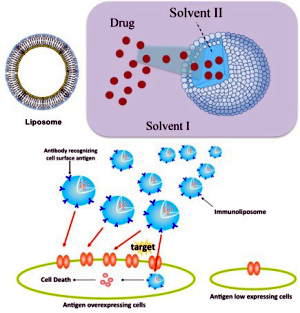 The efficient delivery of chemotherapeutic compounds to cancerous cells are collectively called as drug delivery system. The specificitywhich with the delivery of chemotherapeutic agents ameliorates the possible side effects to the surrounding normal cells. We were successful in the development of a method for the efficient encapsulation of anticancer agents by a unique remote loading method utilizing the difference in the solubility of liposomes (nanocapsules) of diameter 100-200nm which constitutes of a lipid backbone and modification thereforth with a variety of cell surface antigen to enhance the targeting ability. The established nanoparticles are also envisaged to target the biomolecules in the in vivo conditions with least side effects without loss of activity. So far, we have succeeded in encapsulating anti-cancer agents such as cisplatin, paclitaxel glycoside, docetaxel and so on. Targeting HER2, which is well known marker of breast cancer, and metalomatrix protease has been also successful.
The efficient delivery of chemotherapeutic compounds to cancerous cells are collectively called as drug delivery system. The specificitywhich with the delivery of chemotherapeutic agents ameliorates the possible side effects to the surrounding normal cells. We were successful in the development of a method for the efficient encapsulation of anticancer agents by a unique remote loading method utilizing the difference in the solubility of liposomes (nanocapsules) of diameter 100-200nm which constitutes of a lipid backbone and modification thereforth with a variety of cell surface antigen to enhance the targeting ability. The established nanoparticles are also envisaged to target the biomolecules in the in vivo conditions with least side effects without loss of activity. So far, we have succeeded in encapsulating anti-cancer agents such as cisplatin, paclitaxel glycoside, docetaxel and so on. Targeting HER2, which is well known marker of breast cancer, and metalomatrix protease has been also successful.
- Proliferation and differentiation of stem cells for regenerative therapy.
Induction of pancreatic endocrine cell differentiation:
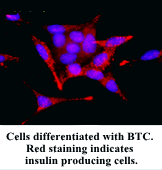 Generation of insulin producing β cells, which are the endocrine cells of pancreas, will be effective against diabetes treatment. Betacellulin, a member of the epidermal growth factor family purified from mouse insulinoma cells, is shown to induce the differentiation of β cells. We have generated specific mutants of betacellulin which accelerates the differentiation of progenitor cells into mature β cells. Until now we have been studying the effect of betacellulin in the rat cells, we are planning to extend the differentiation aspect of betacelluin to iPS for the generation of β cells for regenerative therapy.
Generation of insulin producing β cells, which are the endocrine cells of pancreas, will be effective against diabetes treatment. Betacellulin, a member of the epidermal growth factor family purified from mouse insulinoma cells, is shown to induce the differentiation of β cells. We have generated specific mutants of betacellulin which accelerates the differentiation of progenitor cells into mature β cells. Until now we have been studying the effect of betacellulin in the rat cells, we are planning to extend the differentiation aspect of betacelluin to iPS for the generation of β cells for regenerative therapy.
Induction of Cardiomyocytes:
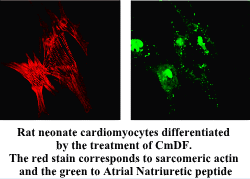 CmDF, a protein isolated from human eosinophil is found to induce the
differentiation of cardiomyocytes, is a promising candidate for the regenerative
medicine. We have been studying the effect of the induction of differentiation
and its mechanism of action for the treatment of cardiomyopathy. The video below
depicts the differentiation of embryonic tumor cell line mouse P19 cells
to cardiomyocytes using CmDF (m4v format, Google Chrome is recommended). Preliminary data suggest CmDF have varied
responses on various cells and using our iPS model we would like to expand
the possible application of CmDF towards regenerative medicine.
CmDF, a protein isolated from human eosinophil is found to induce the
differentiation of cardiomyocytes, is a promising candidate for the regenerative
medicine. We have been studying the effect of the induction of differentiation
and its mechanism of action for the treatment of cardiomyopathy. The video below
depicts the differentiation of embryonic tumor cell line mouse P19 cells
to cardiomyocytes using CmDF (m4v format, Google Chrome is recommended). Preliminary data suggest CmDF have varied
responses on various cells and using our iPS model we would like to expand
the possible application of CmDF towards regenerative medicine.